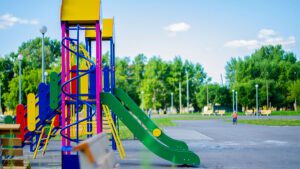A importância dos parques infantis inclusivos
Os parques infantis são mais do que apenas um local para as crianças se divertirem. São ambientes essenciais onde as crianças se desenvolvem física, emocional e socialmente. No entanto, muitas crianças com deficiência perdem esta valiosa oportunidade devido à acessibilidade limitada. Na SPIKE, estamos empenhados em tornar os parques infantis inclusivos, assegurando que as crianças de todas as capacidades possam desfrutar dos benefícios da brincadeira.
Este artigo explora o que torna um parque infantil acessível e inclusivo, como integrar estas caraterísticas e os benefícios de promover a inclusão na sua comunidade.

O que é que torna um parque infantil acessível?
Compreender as normas de acessibilidade
Um parque infantil acessível garante que as crianças com várias capacidades possam utilizar o equipamento e navegar no espaço em segurança. De acordo com o Lei dos Americanos com Deficiência (ADA)Todos os parques infantis construídos após 15 de março de 2012 devem cumprir determinadas diretrizes para serem considerados acessíveis.
As principais caraterísticas de acessibilidade incluem:
- Rotas desobstruídas: Caminhos claros e largos que sejam fáceis de percorrer para as crianças que utilizam ajudas à mobilidade.
- Estações de transferência: Zonas onde as crianças em cadeiras de rodas podem ser transferidas em segurança para o equipamento do parque infantil.
- Caminhos acessíveis: Rampas e caminhos que conduzem ao equipamento dos parques infantis, assegurando transições suaves para todos.
- Pavimentação de segurança: Materiais que amortecem as quedas, cumprindo os requisitos da ADA e as certificações ASTM 1951 para classificações críticas de altura.
Dica profissional: Ao planear um parque infantil, certifique-se de que os percursos são suaves e que existe um acesso fácil aos principais equipamentos de jogo, casas de banho e áreas de estacionamento.

O que é um parque infantil inclusivo?
Ir para além da acessibilidade
Enquanto a acessibilidade permite que as crianças com deficiência entrem no parque infantil, um parque infantil inclusivo cria um ambiente onde podem brincar ao lado dos seus pares. A conceção inclusiva integra caraterísticas que apoiam a interação social, o desenvolvimento cognitivo e a atividade física, garantindo que todas as crianças, independentemente das suas capacidades, possam desfrutar das mesmas experiências.
Os elementos-chave de um parque infantil inclusivo incluem:
- Elementos de jogos sensoriais: Por exemplo, equipamento musical ou superfícies texturadas que envolvem as crianças com perturbações do processamento sensorial.
- Conceção multigeracional: Espaços onde as crianças, as pessoas que cuidam delas e os membros da família de todas as idades podem brincar juntos.
- Espaços tranquilos: Áreas onde as crianças com perturbações do espetro do autismo (ASD) ou sobrecarga sensorial podem retirar-se e reagrupar-se sem se sentirem isoladas.
Dica profissional: Um parque infantil inclusivo promove um sentimento de pertença para todas as crianças. Não se trata apenas de cumprir as diretrizes da ADA, mas de criar um espaço onde todos se sintam bem-vindos e envolvidos.

Porquê tornar o seu parque infantil acessível e inclusivo?
Benefícios dos parques infantis inclusivos e acessíveis
Construir um parque infantil inclusivo não é apenas um requisito legal - é um investimento no bem-estar da sua comunidade. As vantagens são inúmeras:
- Incentivar a empatia e a aceitação: Quando as crianças com e sem deficiência brincam juntas, aprendem a apreciar as diferenças e a desenvolver empatia, promovendo uma sociedade inclusiva.
- Promover o desenvolvimento físico e social: Os parques infantis acessíveis permitem a todas as crianças participar em actividades físicas e interações sociais, melhorando as competências cognitivas, emocionais e sociais.
- Reforçar a participação da família: Um parque infantil inclusivo garante que as crianças com deficiência possam passar tempo com as suas famílias, incluindo os prestadores de cuidados com dificuldades de mobilidade.
- Criar um sentido de comunidade: Um parque infantil bem concebido e inclusivo reúne a comunidade, proporcionando um espaço onde as crianças e as famílias podem construir relações e memórias.
Dica profissional: Ao concentrar-se na inclusão, pode criar um espaço que não só apoia o desenvolvimento das crianças, mas também reforça os laços comunitários.

Como tornar um parque infantil acessível e inclusivo
Passos práticos para a conceção de um parque infantil acessível
Criar um parque infantil acessível e inclusivo não requer um grande orçamento. Ao implementar os seguintes passos, pode tornar o seu parque infantil num local que acolhe todas as crianças:
- Avalie o seu parque infantil atual: Rever as estruturas existentes e identificar as áreas que precisam de ser tornadas acessíveis. Assegurar que os percursos são suaves e não têm obstáculos.
- Avalie as necessidades da sua comunidade: Compreender as necessidades específicas da sua comunidade, incluindo quaisquer requisitos sensoriais ou de mobilidade. Fale com as famílias e com especialistas para obter informações.
- Incorporar elementos sensoriais e interactivos: Acrescente caraterísticas que envolvam vários sentidos, como equipamento de produção de som, painéis tácteis e labirintos sensoriais.
- Instalar rampas e estações de transferência: Assegurar a existência de rampas seguras e fáceis de utilizar, escorregas com estações de transferência e equipamento ao nível do solo para facilitar o acesso.
- Utilizar uma superfície de segurança compatível com a ADA: Escolha materiais macios e que absorvam o impacto, como ladrilhos de borracha, fibra de madeira projectada ou borracha vazada no local para amortecer as quedas.
Dica profissional: Concentre-se em criar uma disposição que favoreça a interação social, assegurando que há espaço suficiente para as crianças de todas as capacidades brincarem juntas.

Equipamento acessível e inclusivo para incluir no seu parque infantil
Para garantir que o seu parque infantil é acessível e inclusivo, considere a possibilidade de incluir os seguintes tipos de equipamento:
- Rampas: As rampas permitem que as crianças que utilizam auxiliares de mobilidade acedam a equipamentos elevados. Procure rampas com corrimãos e espaço suficiente para acomodar utilizadores de cadeiras de rodas.
- Slides inclusivos: Os escorregas acessíveis com pontos de transferência mais baixos e com largura suficiente para que todas as crianças os possam utilizar são essenciais para promover a inclusão.
- Actividades lúdicas ao nível do solo: As actividades ao nível do solo, como as rodas giratórias e as caixas de areia, permitem que as crianças brinquem em conjunto, independentemente das suas capacidades.
- Actividades sensoriais: Incorporar instrumentos musicais, superfícies texturadas e elementos coloridos para envolver as crianças com dificuldades de processamento sensorial.
- Baloiços inclusivos: Os baloiços com assentos que oferecem apoio extra, como os baloiços inclusivos compatíveis com a ADA, permitem que as crianças de todas as capacidades experimentem a emoção de baloiçar.
Dica profissional: Consulte sempre um profissional de conceção de parques infantis para garantir que as suas escolhas de equipamento estão em conformidade com as normas de segurança e as melhores práticas de inclusão.

Oportunidades de financiamento para parques infantis acessíveis e inclusivos
Criar um parque infantil acessível e inclusivo pode parecer um grande empreendimento financeiro, mas existem muitos recursos disponíveis para ajudar a financiar o projeto. Eis algumas formas de garantir o financiamento:
- Candidatar-se a subvenções: Organizações como a KaBOOM! oferecem subsídios para a construção de parques infantis inclusivos. Consulte o nosso Guia de recursos para a concessão de parques infantis para saber mais.
- Organizar angariações de fundos: Organize angariações de fundos na comunidade para angariar fundos para o projeto. Estas acções podem também aumentar o envolvimento e o apoio da comunidade.
- Patrocínios empresariais: Contactar as empresas locais para obter patrocínios ou parcerias que possam fornecer apoio financeiro.
Dica profissional: O envolvimento da comunidade desde o início pode ajudar a espalhar a palavra e a reunir apoio para o seu projeto, tanto financeiramente como através de esforços de voluntariado.

Perguntas frequentes sobre parques infantis acessíveis e inclusivos
Qual é a diferença entre parques infantis inclusivos e acessíveis?
Os parques infantis acessíveis cumprem os requisitos mínimos da ADA, permitindo que as crianças com deficiência tenham acesso ao equipamento de jogo. Os parques infantis inclusivos vão mais além, garantindo que as crianças de todas as capacidades possam brincar juntas e desfrutar das mesmas experiências.
Como é que os parques infantis podem ser mais inclusivos?
Torne o seu parque infantil mais inclusivo, acrescentando equipamento acessível, assegurando percursos suaves e incorporando elementos sensoriais para crianças com diferentes capacidades.
Os parques infantis devem ser inclusivos para alunos de todas as capacidades?
Sim! Os parques infantis inclusivos ajudam as crianças a aprender competências sociais importantes como a empatia, o trabalho de equipa e a aceitação, tornando-as indivíduos mais completos e compassivos.
Conclusão: Construir um parque infantil inclusivo para todos
A conceção de um parque infantil acessível e inclusivo é um dos projectos mais gratificantes que pode realizar. Ao assegurar que o seu parque infantil satisfaz as necessidades de crianças com todas as capacidades, não está apenas a criar um espaço para brincar - está a promover um ambiente em que todas as crianças se sentem bem-vindas e valorizadas.
Na SPIKE Amusement, fornecemos uma vasta gama de equipamentos para parques infantis inclusivos e compatíveis com a ADA, concebidos para satisfazer as necessidades de todas as crianças. Contacte-nos hoje para começar a construir um parque infantil de que todos possam desfrutar!




